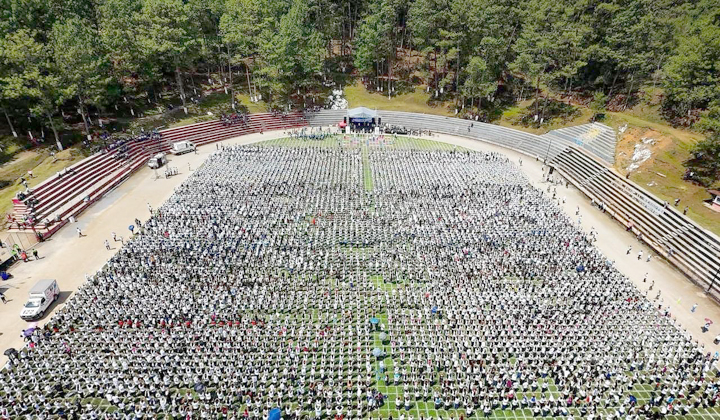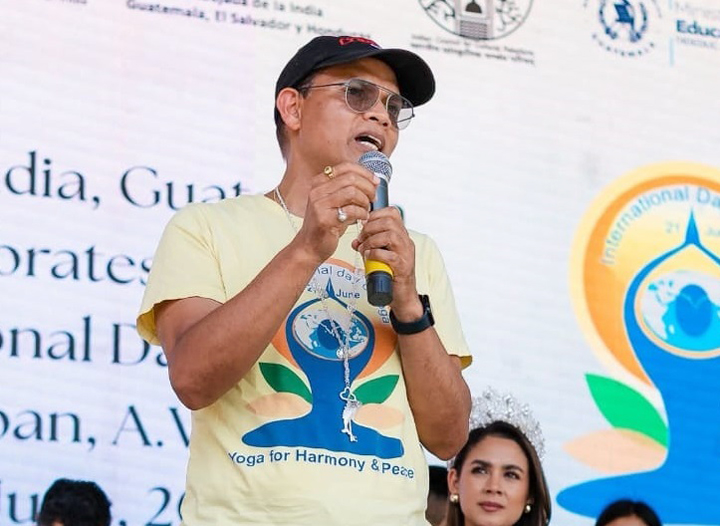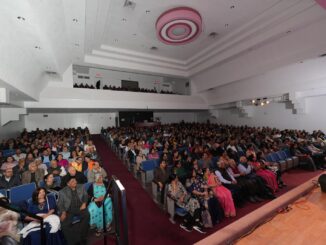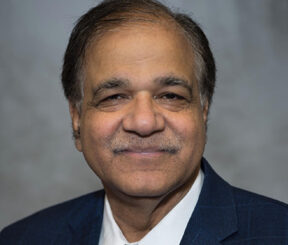
Dr. Manoj Kumar Mohapatra in Conversation with Prof. Indrajit S. Saluja
Dr. Manoj Kumar Mohapatra, India’s Ambassador to Guatemala, El Salvador, and Honduras, recently made headlines by leading the largest-ever International Day of Yoga event outside India. Over 10,000 participants gathered at Carchá, Guatemala, on June 13, 2025, for a celebration of wellness, unity, and Indian philosophy. Days before concluding his term, Ambassador Mohapatra sat down with Prof. Indrajit S. Saluja, Editor of The Indian Panorama, to reflect on his tenure, the deepening of Indo-Central American relations, and his vision for India’s role in the region.
Excerpts from the interview.
TIP: Good morning, Ambassador Mohapatra. Congratulations on organizing a historic yoga event here in Guatemala. With over 10,000 participants and only a small Indian diaspora in the country, it’s astonishing. How did you manage to mobilize such a massive gathering, especially with so many young participants?
Amb. Dr. Mohapatra: Thank you so much, Professor. We’ve been friends for over a decade, and you’ve seen me work in New York and Washington, D.C. My goal has always been to promote Indian culture globally—and yoga, as a gift of India to the world, is central to that mission.

Now, regarding the International Day of Yoga in Carchá, our strategy focused on engaging youth. Young people are the future of any nation, and in a country like Guatemala, where awareness of India is still growing, targeting schoolchildren created an organic way to connect with families and communities. This wasn’t just about organizing an event; it was about creating a movement.
Despite the Indian community here being fewer than 100 families, we intentionally focused on local participation. Our goal has always been people-to-people contact. We wanted Guatemalans to experience Indian culture firsthand. That’s why we worked hard to include school administrations, youth groups, municipal authorities, and the education ministry.

And it’s been building up. Three years ago, our Holi and Diwali celebrations had around 2,000 participants. Last year, it was 5,000. This year, more than 10,000 came together. It became a regional festival. The enthusiasm of the local people, the support from the government, and the underlying message of this year’s theme—“One World, One Health”—all came together beautifully.
I believe this was likely the largest International Day of Yoga celebration outside of India.
TIP: Truly remarkable. It’s not something easily replicated. You’ve clearly established a strong cultural bridge between India and Guatemala. I recall the Holi and Diwali festivals you’ve organized—massive turnouts, enthusiastic local participation.
Amb.: Absolutely. Beyond Guatemala, I’ve extended this outreach to El Salvador and Honduras as well. Two years ago, we celebrated Holi in San Salvador with over 7,000 people. This year, even with shifting political landscapes, more than 3,000 attended.
We’ve celebrated everything—from Gandhi Jayanti and Durga Puja to plantation drives under the “Green Earth” initiative. Over 500 children planted saplings last year. We’ve implemented campaigns aligned with India’s national initiatives, such as “Ek Ped Mahakalyanam” and “LiFE Mission,” while always ensuring inclusivity and local participation.
This year, for example, we took the yoga event 250 kilometers away from the capital to reach communities that would otherwise never interact with India. The idea was to move beyond the capital, beyond our comfort zones.
I must thank the governments of all three countries, the municipal bodies, and especially the young people. Their response has been heartening.
TIP: After more than three and a half years in these three countries, how do you look back at your tenure?

Amb.: I see it holistically. Wherever I’m posted, I ask myself: what legacy can I leave in this short time?
When I arrived, the total bilateral trade between India and the three countries was modest. Today, it exceeds $1 billion. Guatemala alone, with a population of 17 million, is leading among the three—El Salvador has 6.7 million, and Honduras about 10 million.
We’ve facilitated major Indian investments, especially in renewable energy. One company has established a paper production facility using sugarcane bagasse—environmentally friendly and sustainable. Another entered the vegetable oil industry, and Indian businesses are also active in textiles and digital infrastructure.
These aren’t short-term deals. They are long-term engagements. Giants like Adani and Reliance are exploring opportunities, and Jio is laying groundwork for telecom infrastructure. India is no longer just a cultural friend—we are becoming an economic partner.
TIP: What potential do you see for further strengthening these trade relationships?
Amb.: Immense potential. While India traditionally doesn’t interfere in the internal affairs of other nations, geographical distance and limited awareness about India’s rise remain challenges. But every challenge brings opportunity.
When I came here from Washington, D.C., I had extensive experience in economic diplomacy. That experience helped me identify strategic sectors and bring in Indian businesses. We organized 30 to 40 B2B meetings annually.
To guide our work, I introduced the acronym “SPEED”:
S – Supply Chain Management
P – Pharmaceuticals
E – Education
E – Energy
D – Digital
In each of these areas, we’ve seen real results.
India now supplies up to 30% of the pharmaceutical requirements for these countries. Our energy sector, particularly solar, is competitive. Supply chains are stabilizing post-pandemic. Education and digital infrastructure are next frontiers. And we’re positioning India as a dependable long-term partner.

TIP: Central America’s economy is closely tied to the United States. Given the evolving U.S. political and economic climate, how can India strengthen its engagement with the region?
Amb.: That’s an important question. While these countries have historical and trade ties with the U.S., they are now seeking to diversify.
India’s growth—6.5 to 7.5% consistently—has caught their attention. They want to reduce dependency on a single partner. That helps us. But again, geographical distance is a factor.
If India and the U.S. can maintain excellent relations across such distance, why not between India and Central America?
We don’t impose political conditions. Our engagement is apolitical, focused purely on development, commerce, and culture. I believe we’ve succeeded in converting challenges into opportunities.
TIP: India still has a significant trade imbalance with China. Isn’t it necessary for India to find new markets—like these Central American nations—for its goods?
Amb.: Absolutely. But trade is never one-sided. For it to be sustainable, it must be mutually beneficial.
India is one of the largest consumer markets in the world, with over 1.4 billion people. So, while we aim to export, we also import. It’s a two-way street.
Rather than just selling products, we’re encouraging Indian companies to manufacture locally—particularly in textiles and consumer goods. That way, semi-finished goods from India can be processed here and shipped quickly to the U.S. or other Latin American countries.
It’s a classic win-win.
TIP: You’ve worked closely with businesses and governments here. What would you say were your biggest achievements? And were there any regrets or things left unfinished?
Amb.: I wouldn’t call them failures—perhaps areas needing more time.
We’ve laid a strong foundation. For instance, the largest investment in Guatemala in recent years is by an Indian company. We’ve created thousands of jobs. A company that had 400 employees now has 1,500. Another in the energy sector is scaling up rapidly.
India’s presence in sectors like digital infrastructure, textiles, pharmaceuticals, and renewable energy has deepened.
And on the diplomatic side, Honduras has opened an embassy in New Delhi. That’s a significant milestone.
I’ve also worked hard to build genuine friendships. I often say these countries are like Lord Hanuman—they don’t always realize their own strength until reminded. My job was to help them see India as a reliable, rising partner.
TIP: So you’ve built the foundation. Now the next ambassador has a platform to build upon.

Amb.: Precisely. I arrived during the 50th anniversary of diplomatic ties between India and Guatemala. I leave on the 53rd. Three years may seem short, but we’ve made it count.
Continuity is key. As T.S. Eliot said, “Time past is present in time future.” I’ve built on the work of my predecessors and laid the groundwork for my successor. That’s how diplomacy should function.
TIP: You’ve often spoken of “Vasudhaiva Kutumbakam”—the world is one family. That was a powerful message during the yoga session. Would you like to elaborate?
Amb.: Of course. That phrase isn’t just a slogan—it’s a philosophy that guides all our actions.
We don’t undertake initiatives for personal or national gain alone. We share knowledge, technology, and experience generously. That’s India’s ethos.
“Vasudhaiva Kutumbakam” means we see everyone as part of one global family. One sun, one moon, one earth, one health. Our yoga event, the prosthetic limb donation, the medical camps—we did all this to connect people, not to chase headlines.
I’m proud of how the Indian community, our partners in the U.S., and local authorities came together. That’s what diplomacy is truly about.
TIP: Thank you so much, Ambassador Mohapatra. Your vision, leadership, and deep sense of service have left a lasting mark. On behalf of The Indian Panorama and all our readers, we wish you continued success wherever you go next.
Amb.: Thank you, Professor. Your support and that of the Indian diaspora have meant a lot. This isn’t goodbye—it’s just the continuation of a journey. We’ve built a bridge between India and Central America. Now it’s time to walk across it together.





Sweet blog! I found it while surfing around on Yahoo News. Do you have any tips on how to get listed in Yahoo News? I’ve been trying for a while but I never seem to get there! Appreciate it
I am constantly browsing online for ideas that can benefit me. Thanks!
I like this blog very much so much great information.
This blog is definitely rather handy since I’m at the moment creating an internet floral website – although I am only starting out therefore it’s really fairly small, nothing like this site. Can link to a few of the posts here as they are quite. Thanks much. Zoey Olsen
Wohh precisely what I was looking for, thankyou for putting up.
I’ve been exploring for a little bit for any high quality articles or blog posts on this sort of area . Exploring in Yahoo I at last stumbled upon this site. Reading this info So i’m happy to convey that I’ve an incredibly good uncanny feeling I discovered exactly what I needed. I most certainly will make sure to don’t forget this web site and give it a look on a constant basis.
There is noticeably a bundle to know about this. I assume you made certain nice points in features also.
I have read several good stuff here. Definitely worth bookmarking for revisiting. I wonder how much effort you put to create such a magnificent informative site.
Thanks – Enjoyed this post, is there any way I can receive an update sent in an email whenever you publish a fresh post?
There is evidently a bunch to identify about this. I consider you made certain nice points in features also.
Fantastic beat ! I would like to apprentice while you amend your website, how can i subscribe for a blog website? The account helped me a acceptable deal. I had been tiny bit acquainted of this your broadcast provided bright clear concept
It’s a shame you don’t have a donate button! I’d without a doubt donate to this excellent blog! I suppose for now i’ll settle for book-marking and adding your RSS feed to my Google account. I look forward to fresh updates and will talk about this website with my Facebook group. Chat soon!
I’d always want to be update on new blog posts on this web site, saved to my bookmarks! .
Awsome website! I am loving it!! Will be back later to read some more. I am bookmarking your feeds also
I carry on listening to the reports lecture about receiving free online grant applications so I have been looking around for the top site to get one. Could you tell me please, where could i get some?
Amazing! This blog looks exactly like my old one! It’s on a completely different topic but it has pretty much the same page layout and design. Excellent choice of colors!
I’m not that much of a online reader to be honest but your blogs really nice, keep it up! I’ll go ahead and bookmark your website to come back later on. Many thanks
I’d must test with you here. Which is not something I normally do! I enjoy reading a submit that may make folks think. Additionally, thanks for permitting me to comment!
Pretty portion of content. I just stumbled upon your web site and in accession capital to say that I get in fact loved account your blog posts. Anyway I will be subscribing in your feeds or even I achievement you access consistently fast.
This is a very good tips especially to those new to blogosphere, brief and accurate information… Thanks for sharing this one. A must read article.
Good site! I truly love how it is simple on my eyes and the data are well written. I’m wondering how I could be notified when a new post has been made. I’ve subscribed to your RSS which must do the trick! Have a nice day!
I have been exploring for a bit for any high quality articles or blog posts in this sort of space . Exploring in Yahoo I at last stumbled upon this website. Reading this info So i¦m glad to convey that I have an incredibly good uncanny feeling I found out just what I needed. I such a lot undoubtedly will make certain to don¦t disregard this web site and give it a look on a relentless basis.
I’ll right away grab your rss feed as I can not find your email subscription link or e-newsletter service. Do you’ve any? Please let me know in order that I could subscribe. Thanks.
Very interesting subject , thanks for putting up.
I got what you intend,saved to my bookmarks, very decent site.
Hey there! I’m at work browsing your blog from my new iphone 3gs! Just wanted to say I love reading through your blog and look forward to all your posts! Keep up the outstanding work!
Yeah bookmaking this wasn’t a bad conclusion outstanding post! .
Hi, i read your blog from time to time and i own a similar one and i was just wondering if you get a lot of spam remarks? If so how do you reduce it, any plugin or anything you can recommend? I get so much lately it’s driving me mad so any support is very much appreciated.
I went over this web site and I conceive you have a lot of excellent info, saved to bookmarks (:.
Some really nice and utilitarian information on this website , as well I conceive the layout has got good features.
The subsequent time I read a blog, I hope that it doesnt disappoint me as a lot as this one. I imply, I know it was my choice to read, however I actually thought youd have one thing fascinating to say. All I hear is a bunch of whining about something that you possibly can fix for those who werent too busy on the lookout for attention.
Hi my loved one! I wish to say that this article is awesome, great written and include approximately all important infos. I would like to see more posts like this.
naturally like your web site but you need to check the spelling on quite a few of your posts. A number of them are rife with spelling issues and I find it very bothersome to tell the truth nevertheless I will certainly come back again.
Very interesting subject, thankyou for posting. “If you have both feet planted on level ground, then the university has failed you.” by Robert F. Goheen.